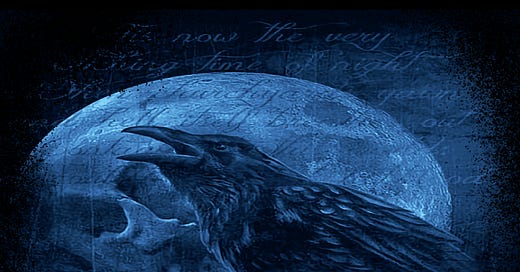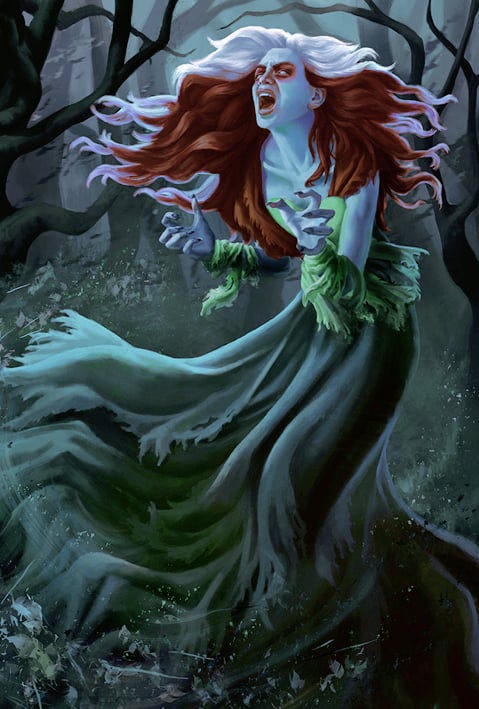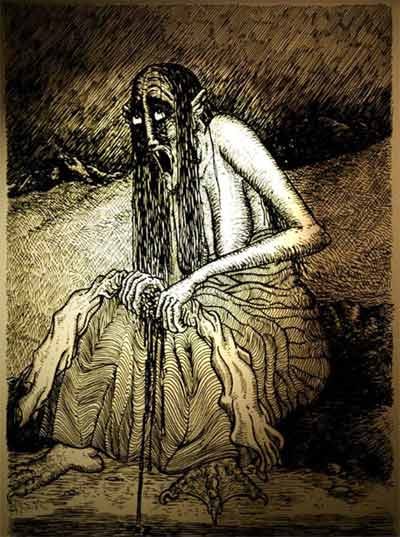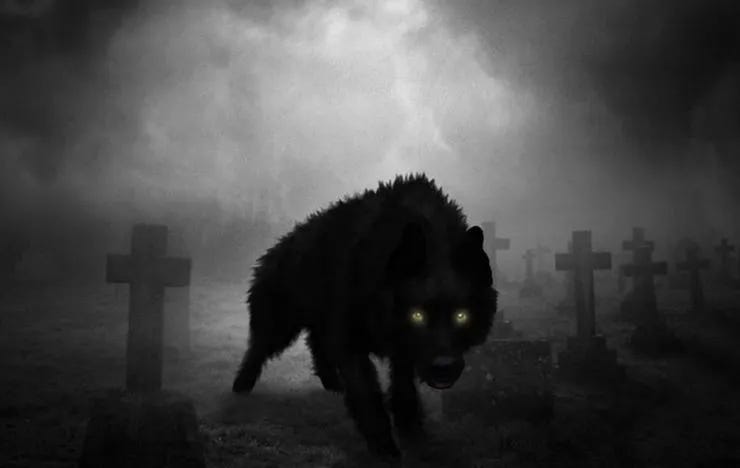We pick on some rather unusual subjects to chat about on our podcast. In the episode entitled "Portents and Omens", we talk about many strange and somewhat unusual things that are said to foretell impending doom for a particular individual. It's surprising just how many of these death omens there are. We barely scratched the surface with the few we touched on, so this may be a theme we return to at some stage.
https://shows.acast.com/outthereparanormal/episodes/portents-omens
Some interesting topics came up during the podcast, and I want to expand further on these subjects.
At the beginning of the episode, we mention a classic harbinger in the shape of the Banshee. So what exactly is a harbinger? A harbinger is a forerunner of something else, a herald, an omen, a sign that something else is coming. A harbinger may signal something negative, a symbol of impending bad luck. However, a harbinger may signal something pleasant too. Of course, we want to concentrate on harbingers of death because we are such cheerful folks.
As I mentioned, let's take a more in-depth look at the Banshee. Although I've kept it simple, it's quite a complicated story full of folklore and mythology. I encourage our readers to dig to find out more.
The Banshee
If you see a banshee, pray for your family's safety. She's a harbinger of death, so one of your family members will join her soon.
However, a banshee doesn't cause death; she merely serves as a warning.
The Banshee is a supernatural being in Irish and other Celtic folklore whose mournful lamentations were believed to foretell the death of a family member of the person who heard the spirit. The word Banshee itself comes from the Gaelic term bean sidhe (pronounced "bane shee"), which means "woman of the fairy mounds." .and is linked to the mythologically important síde (plural form of síd), the Old Irish for tumuli or mounds of earth or stones that dot the Irish countryside. Traditionally, tumuli covered graves and were thought home to the spirits of the dead.
The Banshee's first stories date back to the 8th century. Based on a tradition where women gathered at a funeral and sang a sorrowful song to lament someone's death. These women were known as 'keeners'. Since they accepted alcohol as payment, they were considered sinners and punished by being doomed to become Banshees. This version is just one explanation of Banshee's origin. There are a few variations of where the Banshee originates. It could be the spirit of a woman who died young, possibly by foul means, destined to come back and foretell the deaths of her family, or it could be the spirit of a woman who died in childbirth. The origins are tied to myth and folklore; we may never find the original story.
According to legend, she appears and sings a lamentation or loudly weeps when a member of the family she is attached to is about to die.
The Banshee's appearance varies quite a bit. Some legends say that she is an older woman with red eyes from constantly weeping, long white hair, and wearing a grey cloak over a green dress. Other legends say that the Banshee appears as a pale woman dressed in white, either a dress or shroud, with long red hair. Or as an older woman with a veil covering her face, dressed all in black with long grey hair. Possibly the strangest description is a headless woman carrying a bowl of blood that is naked from the waist up.
The noise the Banshee is said to make is known as keening. This lamentation, or Keening (Irish: Caointeoireacht), is a traditional form of vocal lament for the dead in Gaelic and Celtic traditions. It is known to have taken place in Ireland and Scotland, especially during funeral rituals. As mentioned, the practice is performed by a keening woman (bean chaointe) who wails a lament. This keening woman may sometimes be a professional, and the best keeners would be in high demand.
Keening can be seen as a form of Sean-nós singing. Sean-nós songs cover a range of genres, from a love song to a lament to a lullaby. However, they traditionally have a strong focus on conveying the relevant emotion of the given piece. Keening was performed in the Irish and Scottish Gaelic languages (the Scottish equivalent of keening is known as a coronach).
Keening was once an integral part of the formal Irish funeral ritual. However, it declined from the 18th century and became almost entirely extinct by the middle of the 20th century.
Here's an example of a traditional Irish Keening song.
The ritual of keening explained
In western popular culture, some Banshee tales change the keening into the ability to unleash screams of an inhuman amplitude, capable of shattering glass, cracking rock and causing blood vessels to burst.
The Banshee can attach herself to certain families, following them everywhere, forever doomed to foretell the deaths of each family member. In Ireland, it is said that banshees attach themselves only to Milesian families of pure Irish descent.
There are also similar tales of Banshee-type creatures signalling impending doom in Scottish folklore, which is unsurprising as there are such close links between Scotland and Ireland. I could take you down the rabbit hole of Irish settlement in Dal Riata and the rise of the Scotti, but I decided to keep it simple instead.
So let's take a trip north of the border to Scotland and look at their Banshees.
The Washer at the Ford
There are a few Gaelic Scottish Banshee variations that I want to look at in more detail. The strange thing about the Scottish Banshee variations is that they all resemble washerwomen. They have been given the titles the washer at the ford and the little washerwoman. They can often manifest by rivers and streams and will be washing the death shrouds or clothing of the person whose death they are announcing. I want to look at a few variations, so let's begin with The Bean Nighe.
The Bean Nighe
Similarly to the Banshee, as mentioned earlier, the Scottish Bean-Nighe (pronounced ben-nee’-yeh) was believed to be a harbinger of approaching death. However, how she informs of impending death differs significantly from the Irish Banshee.
You can encounter The Bean-Nighe either sitting beside or sometimes paddling in remote streams and the shallows of rivers. Often seen washing blood from clothing or rinsing funeral shrouds, these items are said to belong to the person whose death she is foretelling. The Bean-Nighe is a small and hideous woman with a hooked nose and one large nostril. She has one sizeable protruding tooth, webbed feet, and long hanging breasts., which she throws over her shoulder as she goes about her task. Sometimes She can be dressed in green, a colour often associated with the fae folk.
These creatures are said to be the souls of women who died whilst giving birth, doomed to remain on this earth until Judgement Day or, as it is more frequently thought, until the day they would otherwise have died. As a grim consequence of their fate, they are also aware of all the other people to be visited by death.
The Bean Nighe is more of a silent harbinger. She can sometimes be heard softly singing as she washes but does not keen or lament like the Banshee. Instead, she cleans the clothes of the person who will die whilst crooning a low mournful dirge to herself that recounts the name of the person whose shroud she washes. The Bean-Nighe is much more capable of involvement with the human world than the Banshee—most likely due to her eventual ability to rejoin them in the afterlife.
In any case, the creature is so absorbed in her washing and singing a mournful dirge for those about to die that it's possible to catch her. In some places, she is caught simply by placing yourself between her and the stream. In other tales, you must sneak up on her and grab her by surprise without her noticing you. If you succeed, your reward could be a wish, or she may tell you whose shroud she is washing. If she says the clothing she is washing belongs to your enemy, you can allow the washing to continue. Still, if it belongs to any of your friends, you can stop her from completing her task and help them avoid their fate. Sometimes when the Bean-Nighe speaks with a human, the human has to answer three of her questions to obtain three answers to his own.
In another more dubious variation, you can sneak up on her while she's washing and suckle from one of her breasts before she sees you. A task made easier by the fact that the Bean-Nighe slings her breasts over her shoulder whilst undertaking her washing tasks. If you succeed, you must tell her that you are her foster child, and she will reveal whatever knowledge you want or grant you a wish.
Bear in mind. However, if the Bean-Nighe sees you first, you could lose a limb or even die! So avoiding the Bean-Nighe is the best course of action!
On Islay, they call the Bean-Nighe a Caointeach. She also haunts desolate streams and washes the clothing of those about to die. Still, in this context, the Caointeach is more formidable. If she is interrupted, she will strike at a person's legs with her wet linen, and the victim will lose the use of them.
A famous Highland story tells of a maiden walking along a loch in Cromarty on a Sunday morning when she comes across a Bean-Nighe washing over 30 bloodied shirts in the loch. After seeing the Bean-Nighe and returning to the village, the roof of the Fearn Abbey collapsed during the Sunday morning service, burying the congregation in debris and killing thirty-six people.
Interestingly, the abbey roof collapse did happen in 1742. A record exists in written history, with the death toll recorded as more than fifty people.
The Caoineag
The Caoineag is a Scottish spirit similar to the Irish Banshee. Her name derives from the Gaelic caoin, meaning weep, and caoidh, meaning mourn. She is one of the Fuath, the malevolent spirits or fairies that inhabit Scotland's waters. The Caoineag is another variation of the little washerwomen style of harbinger. Sightings of her are rare, but you can hear her wailing and weeping at night near waterfalls, streams, and other bodies of water. On the rare occasions she is seen, she will take the form of a young woman, often dressed in green, crouched by the water washing the blood out of clothing. Her prophecies are a little more specialised, and she tends to warn clan members of a forthcoming death in battle.
Similarly to the Irish Banshee, the Caoineag is attached to certain clan families. Each clan has their Caoineag, who foretells the death of clan members and mourns for those slain in combat. Clans and families associated with the Caoineag include the Curries, Duffies, MacDonalds, Macmillans, Mackays, Macfarlanes, Mathisons, and Shaws.
Upon hearing her cries, ask the question, Co tha siad? Who is that? And the answer is given, Co ach Caoineachag, co ach Caoineachag bheag a bhroin. Who but Caoineag, who but little Caoineag of the sorrow.
The Caoineag's harrowing cries understandably caused great anxiety to those who heard them, especially before a battle, or to parents whose sons were in the wars.
The Caoineag of the MacDonalds was heard to wail night after night before the Massacre of Glencoe. The residents of the Glen acknowledged this well-known warning of impending doom. However, it prompted many people to leave before the massacre, thus escaping the terrible fate of the 38 people killed.
Alexander Carmichael, the Scottish Folklorist, collected Fragments of the dirges reputedly sung by the Caoineag before the massacre.
Little Caoineachag of the sorrow
Is pouring the tears of her eyes
Weeping and wailing the fate of Clan Donald
Alas, my grief that ye did not heed her cries
There is gloom and grief in the mount of mist.
There is weeping and calling in the mount of mist.
There is death and danger; there is maul and murder
There is blood spilling in the mount of mist
Unlike the Bean-Nighe, you cannot approach Caoineag, question her, or ask for your wish to be granted. The Caoineag is heard more than seen.
So there you have it, harbingers undertaking a similar task in their unique way. According to legend, they did not predict the viewer's death, nor were they recorded as directly causing someone's death; they were simply the announcers of an individual's fate.
The Church Grim
Sometimes things grab me, an unusual or intriguing name or perhaps an expression I’ve not heard before, and it piques my interest. This was certainly the case when, by chance, I stumbled across the term church grim while researching for the Portents and Omens podcast.
So what is a church grim?
The Church Grim, Kirk Grim, Kyrkogrim (Swedish) or Kirkonväki (Finnish) is a figure from English and Scandinavian folklore, said to be a sentinel spirit overseeing the welfare of its particular Church and graveyard. They may appear as black dogs (sometimes as other animals, such as rams, horses, roosters or ravens) or as small, misshapen, dark-skinned people. There has always been a tradition that every historic graveyard and even some modern cemeteries have what is known as a ‘Churchyard Guardian’ or ‘Church Grim’.
So where do these Church grim come from?
They are said to be the spirits of animals sacrificed at the building of a new church. In parts of Europe, including Britain and Scandinavia, it was believed that the first man buried in a new churchyard had to guard it against the Devil. To save a human soul from the duty, a completely black dog would be offered as a foundation sacrifice, buried alive on the north side of the churchyard, creating a guardian spirit, the Church grim, to protect the Church and its grounds.
These black dogs can be the size of a calf, with a shaggy black coat and glowing, sometimes fiery red eyes. They are always solitary. Wandering black dogs may be encountered in almost any church area, standing guard over their domain generally at night. If anyone tries to strike it or take any other evil action, the dog will use its supernatural power to strike the offender blind, dumb, mad or worse.
Though usually not seen as such, the Church grim can sometimes be a harbinger too. According to Yorkshire tradition, the Church grim also serves as an omen that foreshadows death. It’s known to toll the church bell at midnight before a death occurs. During funerals, clergypersons would see it in the church tower and depending on its aspect, they could determine if the deceased's soul was destined for Heaven or Hell.
As it stands, a Church Grim is a silent and deadly protector of the sanctity of death, ensuring that everything from necromancy to demonic possession is thwarted to uphold natural order.
Of course, this Church grim may also form the basis for many other black dog tales in the UK. For example, in East Anglia, we have the black shuck, a large black dog with glowing eyes that is seen as a harbinger.
So there you have it, folks, two interesting subjects from one of our podcasts that just needed a bit more of an explanation. I hope you enjoyed my deeper delve into the background stories of the Banshee and the Church Grim. Why not dig to see what other information you can discover?








